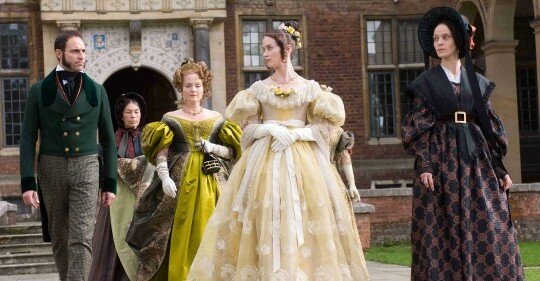The Young Victoria is another visually lush period presentation of life within the parameters of luxury, beauty and power which constructs yet another entangled tale of drama and historical inaccuracy. Directed by French-Canadian Jean-Marc Vallèe, The Young Victoria is a snapshot of the Queen’s early days and her experiences with falling in and out of civil popularity up until the birth of her first child, where the film abruptly ends. Despite the fact that Emily Blunt steals the show as the young Victoria herself, her efforts are only enough to slow the sinking of this film. Gosford Park Screenwriter Julian Fellowes does his best to convey the turbulent youthful years of England’s longest ever serving Monarch, but fails to find the point where teenage angst on account of parental pressure, first love and isolation culminate with the excitement, frustration and fear that comes with being hailed the youngest Queen in British history. Many viewers may also find an entertaining similarity between the characters of Victoria and Sophia Coppola’s Marie Antoinette. This film had the potential to be just as fresh and excitable as Victoria’s youth, but has fallen under the period-drama cookie-cutter instead.
In observation, The Young Victoria does succeed in portraying a beautiful young woman trapped in the games of power hungry men, but fails to provide insight into the way the real Victoria fought for her countrymen and held her own in the royal court. After promising some grand things, the opening credits only serve as benchmarks for action that Fellowes and Vallèe could have hit…or at least could have tried to incorporate into their adaptation of truly exciting real life events. As promising as this film began, the ending comes as sharply and as teasingly as the opening credits, offering a plethora of intriguing facts about Victoria, Albert and the life they shared with the English people, only to cut short. This is without ever showing any real dramatic action: The revolutionary virtues of the Queen, her influences in the advancements of education, welfare and industry were never expressed substantially more than as passing thoughts, and her rule of the monarch is really only shown as her ability to dodge hostile and gossipy conditions within the palace walls.
![the_young_victoria13[1] the young victoria131 305x202 custom The Young Victoria (Review)](/wp-content/uploads/the_young_victoria131-305x202-custom.jpg)
|
The strong British cast work well together, with Jim Broadbent as King William still as quirky as ever, and clearly continuing to glow after his fine form earlier this year in Harry Potter and the Half-Blood Prince. Harriett Walter as Queen Adelaide is a darling – her advice, sympathy and genuine love for her niece, her husband’s predecessor, is what makes her memorable.
Unfortunately for Blunt, not much of the sass she worked so well in The Devil Wears Prada was afforded her character here, although a wasted opportunity to make her character seem more daring, more funny and mostly, more human. Blunt and her counterpart Rupert Friend, as Prince Albert, do give The Young Victoria some hold over other period dramas – their love is passionate and feels real enough, when many historical romances continue to be portrayed as male-dominated-and-dull power struggles – but this is not enough to set the film apart from a visual representation of a Mills and Boon novel. If you find yourself rubbing your eyes to get a clearer look at what is happening in Victoria’s world, don’t worry because it isn’t you – cinematographer Hagen Bogdanski finds it somehow necessary to substitute most camera movement for the handy pull focus, but after several, this only becomes annoying… and not at all “arty”.
Between the bookends, the audience are subjected to anticipating each letter passed between Victoria and Albert, and the politically motivated but not at all romantic advancements of Lord Melbourne, as if in real time. The main point of action happens so late in the game and is weirdly used as the plot point that spurs on the resolution. This occurs when Albert throws himself between his love and a bullet intended for her head, only to receive a grazed arm and the acceptance he needs to fully stand alongside his woman in a position of power and not just as a “poor man with a rich wife”. The incident, although historically inaccurate as Albert was never hurt in any one of Victoria’s many assassination attempts, had the potential to convey a real sense of fear and adrenalin to the audience but denies this by utilising an extended period of slow motion. This effectively stops the pulse of the one trickle of action without heightening the drama at all.
![the_young_victoria06[1] the young victoria061 310x205 custom The Young Victoria (Review)](/wp-content/uploads/the_young_victoria061-310x205-custom.jpg)
|
While the gold here is mostly expressed through Victoria’s disdain for cutthroat dalliances in politics and the royal power games played by all, her entrapment is cheesily evoked through imagery of iron window bars, heavy, locking gates and the exploitation of the game of chess as a constantly referenced metaphor for her own battles. Watching the chess scenes and one out of place, chess themed dream sequence, were like awaiting a train that was not coming…aside from provoking intrigue surrounding the relationships within a plot line that went nowhere, they simply felt unnatural for Blunt and Friend. When Victoria finally breaks under the pressure of gossip and manipulation, Albert is the one subjected to her rage – and he is the one who only truly cares for her.
For a film produced by Scorsese and the Duchess of York, Sarah Ferguson, it is easy to see who had a say in the way this film was made. Disappointingly, this film has replaced factual events with ones that have been fictionally “heightened”, despite the fact that a more entertaining movie could probably have been made from a greater use of the source material in the first place. This film does score points for appropriate casting, and the beautiful location shooting gives this work a postcard-from-Buckingham-palace feel. Hopefully more attempts to tell the story of Queen Victoria will be made, because despite the conveyance of her world in this film, she did live an interesting and turbulent life.







![A Simple Heart [Un coeur simple] (Review) A Simple Heart [Un coeur simple] (Review)](/wp-content/uploads/coeur3351-150x150.gif)








